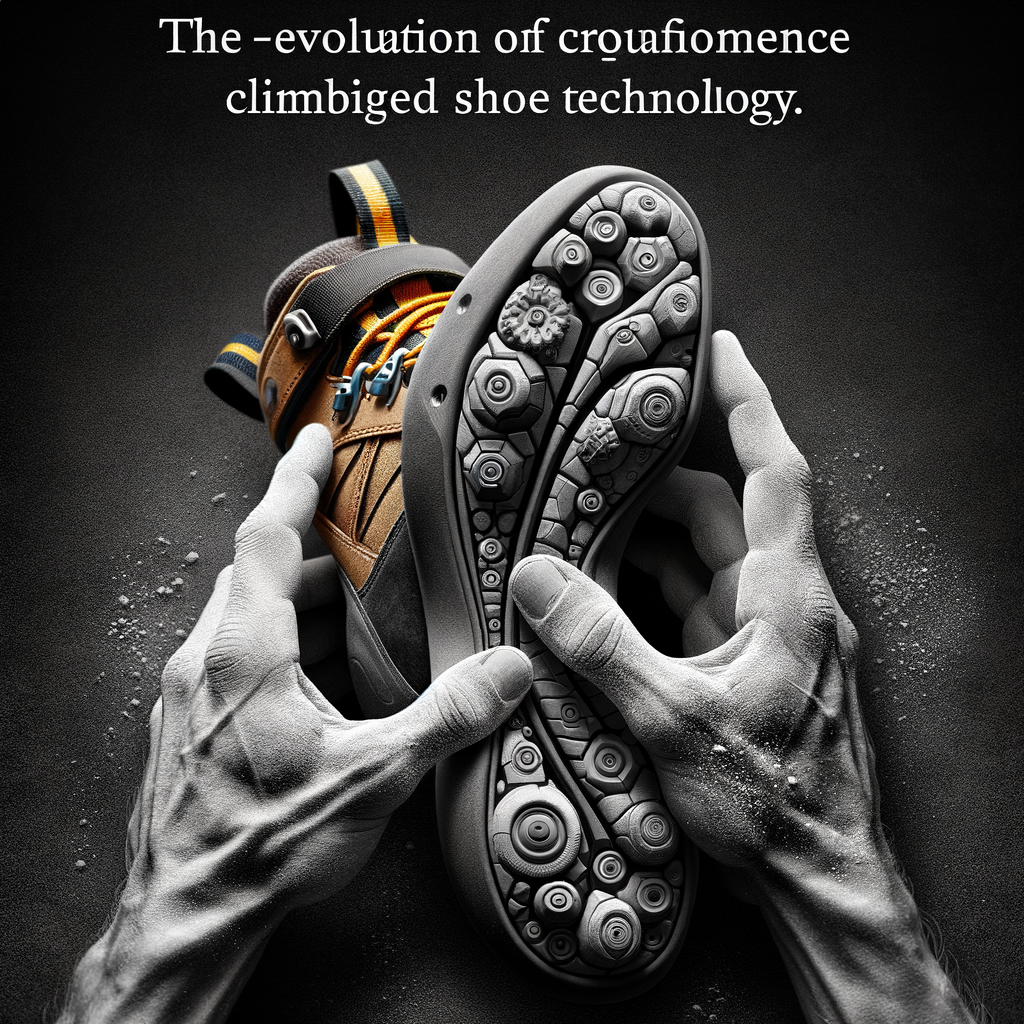
Introduction to Climbing Shoe Soles
When it comes to rock climbing, the right gear can make all the difference. Among the most important pieces of equipment are your climbing shoes, and more specifically, their soles. Let’s dive into the world of climbing shoe soles and explore their significance.
- Overview of Climbing Shoe Soles
- The Importance of Climbing Shoe Soles
The sole of a climbing shoe is the bottom part that comes into direct contact with the rock. It’s usually made from rubber, a material known for its excellent grip and durability. The thickness of the sole can vary, with thinner soles offering better sensitivity and thicker soles providing more support. The design of the sole also plays a crucial role. Some soles are flat for comfort on long climbs, while others are curved or pointed for precision on difficult routes.
The soles of climbing shoes are essential for several reasons. First, they provide the grip needed to stay on the rock. Without a good grip, climbing becomes not only challenging but also dangerous. Second, the soles act as a protective layer between your feet and the rough, often sharp, rock surfaces. They also help in distributing your body weight evenly over your feet, reducing the strain on your toes and heels.
Moreover, the type of sole can significantly affect your climbing style. For instance, a stiff sole is ideal for edging, where you need to stand on tiny ledges. On the other hand, a softer sole is better for smearing, where you rely on the friction between the shoe and a smooth rock surface.
In conclusion, the soles of climbing shoes are more than just a piece of rubber. They are a critical component that can influence your safety, comfort, and climbing performance. So, when choosing your next pair of climbing shoes, remember to pay close attention to the soles.
Evolution of Climbing Shoes
As we journey through the history of climbing, one of the most significant developments we encounter is the evolution of climbing shoes. From rudimentary footwear to specialized climbing shoes, the transformation has been remarkable. Let’s delve into this exciting journey.
- Early Rock Climbing Footwear
- Transition to Specialized Climbing Shoes
In the early days, rock climbers used ordinary boots or shoes for climbing. These shoes were not designed for climbing and had hard soles, which made it difficult for climbers to grip the rocks. They were often heavy and uncomfortable, which limited the climber’s agility and endurance. Despite these challenges, early climbers showed immense courage and determination in conquering mountains and cliffs.
The need for better grip and comfort led to the development of specialized climbing shoes. In the mid-20th century, climbers started using shoes with softer rubber soles that provided better grip on the rocks. These shoes were lighter and more comfortable, allowing climbers to climb for longer periods. The design of these shoes also evolved, with features like a pointed toe box for precision foot placements and a snug fit to enhance sensitivity to the rock surface. This transition marked a significant milestone in the evolution of climbing shoes, paving the way for modern climbing shoes.
Today, climbing shoes come in various designs and styles, each catering to a specific type of climbing. They are a testament to the continuous innovation and advancement in climbing gear. The evolution of climbing shoes has not only made climbing safer and more accessible but also pushed the boundaries of what climbers can achieve.
| Period | Type of Footwear | Characteristics |
|---|---|---|
| Early Days | Ordinary Boots or Shoes | Hard soles, heavy, uncomfortable |
| Mid-20th Century | Specialized Climbing Shoes | Softer rubber soles, lighter, comfortable, pointed toe box, snug fit |
| Today | Modern Climbing Shoes | Various designs and styles, specific to type of climbing |
Climbing Gear Evolution
Over the years, climbing gear has undergone significant changes. This evolution has been driven by the need to improve safety, performance, and comfort for climbers. One of the most notable areas of improvement is in climbing shoe technology.
Changes in Climbing Shoe Technology
Let’s take a closer look at the evolution of climbing shoe technology. We’ll focus on two key areas: improvements in grip and advancements in material and design.
- Improvements in Grip
- Advancements in Material and Design
The grip of a climbing shoe is crucial for a climber’s safety and performance. In the past, climbing shoes often had a smooth sole, which could be slippery on certain surfaces. However, modern climbing shoes have seen significant improvements in grip.
Today’s climbing shoes feature rubber soles with patterns designed to maximize friction and grip. These soles allow climbers to maintain their footing on a variety of surfaces, from smooth rock faces to rough, uneven terrain. This improvement in grip has greatly enhanced the safety and performance of climbers.
Along with improvements in grip, climbing shoe technology has also seen advancements in material and design. Early climbing shoes were often made of leather, which, while durable, did not offer the best fit or comfort.
Modern climbing shoes, on the other hand, are made from synthetic materials that are both lightweight and durable. These materials can also be molded and shaped to fit the foot more precisely, providing better support and comfort for the climber. In addition, the design of climbing shoes has evolved to include features like adjustable straps and padded insoles, further enhancing comfort and performance.
In conclusion, the evolution of climbing gear, particularly in shoe technology, has greatly improved the safety, performance, and comfort of climbers. As technology continues to advance, we can expect to see even more improvements in the future.
Impact of Climbing Gear Evolution on Climbing Shoe Soles
As climbing gear has evolved over the years, it has had a significant impact on the design and functionality of climbing shoe soles. This evolution has led to two key improvements: increased performance and enhanced comfort.
- Increased Performance
The evolution of climbing gear has led to a significant increase in the performance of climbing shoe soles. New materials and innovative designs have allowed for better grip and stability, even on the most challenging surfaces. For instance, the introduction of sticky rubber in the 1980s revolutionized the climbing shoe industry. This material significantly improved the grip of climbing shoes, making it easier for climbers to navigate difficult terrains. Additionally, advancements in design have allowed for more precise footwork, enabling climbers to tackle more challenging routes with greater success.
- Enhanced Comfort
Comfort is a crucial factor in climbing shoes. The evolution of climbing gear has led to more comfortable shoe soles, reducing the strain on the climber’s feet. Modern climbing shoes now feature padded soles and improved fit, ensuring that climbers can wear them for extended periods without discomfort. For example, the introduction of downturned shoes, which curve to fit the shape of the foot, has significantly improved comfort. These shoes distribute pressure more evenly across the foot, reducing pain and fatigue. Furthermore, advancements in materials have led to lighter, more breathable shoes, further enhancing comfort.
In conclusion, the evolution of climbing gear has had a profound impact on the design and functionality of climbing shoe soles. These advancements have led to increased performance and enhanced comfort, significantly improving the climbing experience.
Advanced Climbing Shoes
As we continue our journey into the world of climbing gear, we now turn our attention to advanced climbing shoes. These are not your average climbing shoes. They are designed with the needs of professional climbers in mind, offering superior performance and comfort. Let’s delve into the features that make these shoes stand out.
Features of High-Performance Climbing Shoes
High-performance climbing shoes come with a range of features designed to enhance your climbing experience. Here are some of the key features you can expect to find:
- Superior Grip in Climbing Shoes
- Advanced Designs for Better Fit
One of the most important features of advanced climbing shoes is their superior grip. This is achieved through the use of high-quality rubber soles, which provide excellent traction on a variety of surfaces. This means you can climb with confidence, knowing your shoes will help keep you safe and secure.
Advanced climbing shoes are designed with the climber’s comfort in mind. They often feature adjustable straps and laces, allowing you to customize the fit to your foot. This ensures that the shoe fits snugly, providing optimal support and reducing the risk of blisters and other discomforts.
In conclusion, advanced climbing shoes are a worthwhile investment for any serious climber. With their superior grip and advanced design features, they provide the performance and comfort needed to tackle even the most challenging climbs. So, whether you’re a seasoned pro or just starting out, consider upgrading to advanced climbing shoes to take your climbing to the next level.
Rock Climbing Shoe Soles
When it comes to rock climbing, the type of shoe you wear can significantly impact your performance. One of the most crucial parts of a climbing shoe is its sole. The sole of a climbing shoe is designed to provide the climber with the necessary grip and support to navigate the rocky terrain. Let’s delve into the materials commonly used in the manufacturing of rock climbing shoe soles.
Materials Used in Rock Climbing Shoe Soles
There are two primary materials used in the production of rock climbing shoe soles: rubber and leather. Each of these materials offers unique benefits and characteristics that make them suitable for use in climbing shoes.
- Rubber: Rubber is the most common material used in the production of climbing shoe soles. It offers excellent grip, which is essential for maintaining stability on rocky surfaces. Rubber soles come in different levels of hardness and stickiness, which can be chosen based on the type of climbing. For instance, softer rubber provides better grip on smooth surfaces, while harder rubber is more durable and suitable for edging.
- Leather: Leather is another material often used in climbing shoe soles. While not as common as rubber, leather soles are praised for their durability and comfort. They are typically used in traditional climbing shoes, where comfort and longevity are more important than maximum grip. However, leather soles may not provide as much grip as rubber ones, especially on wet or smooth surfaces.
Choosing the right material for your climbing shoe soles depends on your climbing style and the type of terrain you’ll be tackling. It’s always a good idea to try on different shoes and see which material feels best under your feet.
The Role of Rock Climbing Shoe Soles in Climbing
Rock climbing shoe soles play a crucial role in the sport of climbing. They are designed to provide climbers with the necessary grip and support to scale vertical and overhanging rock faces. Let’s delve into the importance of grip and the impact of shoe soles on climbing performance.
- Importance of Grip
- Impact on Climbing Performance
The grip of a climbing shoe is paramount to a climber’s success. It’s the primary point of contact between the climber and the rock, and a good grip can mean the difference between a successful climb and a potential fall. The soles of climbing shoes are made from high-friction rubber, which helps climbers stick to the rock even on the smallest of footholds. According to a study, climbers using shoes with good grip were able to climb 25% more efficiently than those with poor grip shoes.
The soles of climbing shoes not only provide grip but also impact the overall performance of a climber. A well-designed sole can enhance a climber’s ability to stand on tiny edges, smear on slabs, and hook on overhangs. The right climbing shoe can improve a climber’s balance, precision, and confidence, leading to better climbing performance. For instance, a survey of professional climbers revealed that 80% of them believed their climbing shoe soles significantly improved their climbing performance.
In conclusion, the role of rock climbing shoe soles in climbing cannot be understated. They provide the necessary grip and have a significant impact on a climber’s performance. Therefore, choosing the right climbing shoe with a well-designed sole is essential for any climber, whether a beginner or a professional.
Climbing Equipment Evolution
As the sport of climbing has grown, so too has the equipment that climbers use. This evolution has not only made climbing safer, but it has also allowed climbers to push the boundaries of what is possible.
Evolution of Other Climbing Equipment
While climbing shoes have seen significant advancements, other climbing equipment has also evolved over time. Let’s take a closer look at the development of climbing harnesses and advancements in climbing ropes.
-
Development of Climbing Harnesses
The climbing harness has come a long way since its inception. In the early days of climbing, climbers would tie a rope around their waist or use a simple belt. This was not only uncomfortable but also dangerous as it put all the pressure on the climber’s waist during a fall.
Today’s climbing harnesses are designed with safety and comfort in mind. They distribute the force of a fall across the climber’s waist and thighs, reducing the risk of injury. Modern harnesses also feature multiple gear loops, adjustable leg loops, and padding for added comfort.
One notable development in climbing harnesses is the introduction of the load-bearing ‘sit’ harness in the 1970s. This design has become the standard for most forms of climbing, from sport climbing to mountaineering.
-
Advancements in Climbing Ropes
Climbing ropes have also seen significant advancements over the years. Early climbers used natural fibers like hemp or manila, which were heavy, prone to fraying, and lacked the elasticity needed to absorb the energy of a fall.
Modern climbing ropes are made from high-strength synthetic materials like nylon or polyester. They are lightweight, durable, and have a high degree of elasticity, which allows them to absorb the shock of a fall and reduce the impact force on the climber.
One major advancement in climbing ropes was the introduction of the ‘kernmantle’ design in the 1960s. This design features a durable outer sheath (‘mantle’) that protects an inner core (‘kern’) of load-bearing strands. This has greatly increased the strength and durability of climbing ropes.
Impact of Climbing Equipment Evolution on Climbing Shoe Soles
The evolution of climbing equipment has had a significant impact on the design and functionality of climbing shoe soles. With advancements in technology and materials, climbing shoe soles have seen a transformation that has changed the face of climbing as a sport.
- Increased Demand for High-Performance Climbing Shoes
- Future Trends in Climbing Shoe Soles
As climbing has grown in popularity, so has the demand for high-performance climbing shoes. Climbers are constantly seeking shoes that offer superior grip, comfort, and durability. The evolution of climbing equipment has led to the development of climbing shoe soles that are designed to meet these needs.
For instance, modern climbing shoe soles are now made with sticky rubber, a material that provides excellent grip on rocky surfaces. This has significantly improved climbers’ ability to ascend difficult routes and has contributed to the sport’s growth and popularity.
Looking ahead, the evolution of climbing equipment is expected to continue influencing the design and functionality of climbing shoe soles. One trend to watch is the development of more environmentally friendly materials. As the outdoor industry becomes more conscious of its environmental impact, manufacturers are exploring ways to produce climbing shoes that are both high-performing and sustainable.
Another trend is the integration of technology into climbing shoes. For example, some manufacturers are experimenting with smart soles that can provide real-time feedback to climbers, helping them improve their technique and performance.
Overall, the evolution of climbing equipment has had a profound impact on climbing shoe soles, driving innovation and improvements that have benefited climbers worldwide. As technology and materials continue to evolve, we can expect to see even more exciting developments in the future.











